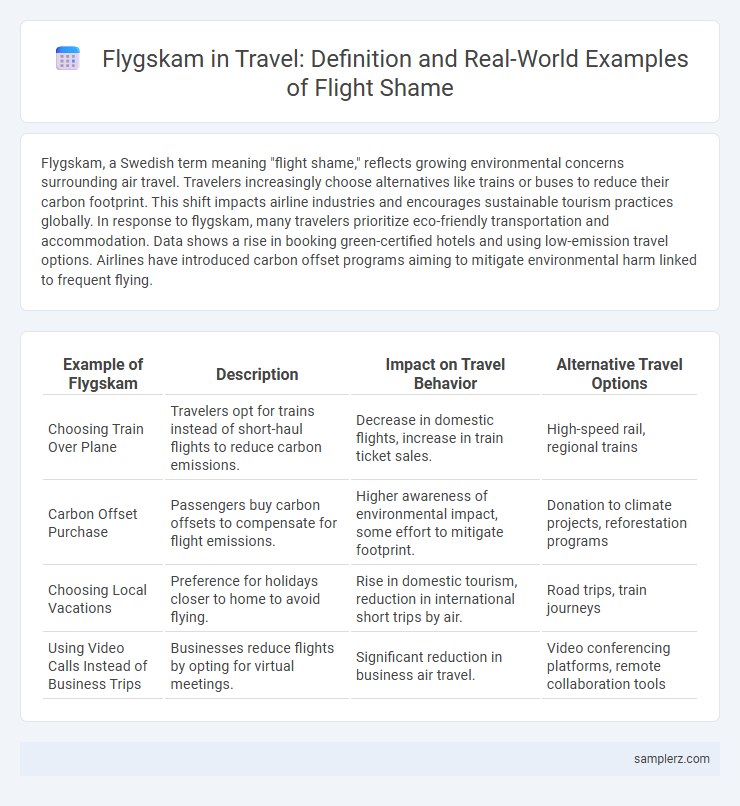Flygskam, a Swedish term meaning "flight shame," reflects growing environmental concerns surrounding air travel. Travelers increasingly choose alternatives like trains or buses to reduce their carbon footprint. This shift impacts airline industries and encourages sustainable tourism practices globally. In response to flygskam, many travelers prioritize eco-friendly transportation and accommodation. Data shows a rise in booking green-certified hotels and using low-emission travel options. Airlines have introduced carbon offset programs aiming to mitigate environmental harm linked to frequent flying.
Table of Comparison
| Example of Flygskam | Description | Impact on Travel Behavior | Alternative Travel Options |
|---|---|---|---|
| Choosing Train Over Plane | Travelers opt for trains instead of short-haul flights to reduce carbon emissions. | Decrease in domestic flights, increase in train ticket sales. | High-speed rail, regional trains |
| Carbon Offset Purchase | Passengers buy carbon offsets to compensate for flight emissions. | Higher awareness of environmental impact, some effort to mitigate footprint. | Donation to climate projects, reforestation programs |
| Choosing Local Vacations | Preference for holidays closer to home to avoid flying. | Rise in domestic tourism, reduction in international short trips by air. | Road trips, train journeys |
| Using Video Calls Instead of Business Trips | Businesses reduce flights by opting for virtual meetings. | Significant reduction in business air travel. | Video conferencing platforms, remote collaboration tools |
Understanding Flygskam: The Rise of Flight Shame in Travel
Flygskam, or flight shame, has emerged as a significant social movement encouraging travelers to reduce air travel due to environmental concerns, particularly carbon emissions. Originating in Sweden, this phenomenon has influenced millions globally to choose more sustainable travel options such as trains or buses. Airlines and tourism industries are increasingly pressured to adopt greener technologies and promote eco-friendly practices to address the growing demand for climate-conscious travel.
Real-Life Stories of Travelers Embracing Flygskam
Travelers embracing flygskam share real-life stories of opting for eco-friendly alternatives such as train journeys across Europe or cycling tours through scenic routes to reduce their carbon footprint. One notable example includes a couple who chose a month-long sailing trip instead of flying to explore Mediterranean destinations, highlighting their commitment to sustainable travel. These personal experiences showcase a growing movement where conscious travel decisions prioritize environmental impact over convenience.
Popular Alternatives to Air Travel Among Conscious Tourists
Conscious tourists increasingly choose train travel as a popular alternative to flying, reducing carbon emissions by up to 90% compared to air travel. Long-distance bus services and carpooling also serve as eco-friendly options, offering flexibility while minimizing environmental impact. Cycling and slow travel options attract travelers seeking immersive experiences with a significantly lower carbon footprint.
Celebrity Advocates Leading the Flygskam Movement
Celebrity advocates such as Greta Thunberg and Leonardo DiCaprio have significantly propelled the flygskam movement by publicly reducing air travel and promoting sustainable alternatives. Their influence has raised global awareness of aviation's carbon footprint, encouraging travelers to choose trains, trains, or eco-friendly transportation methods. These high-profile endorsements have sparked widespread dialogue on climate-conscious travel choices and inspired policy shifts toward greener mobility options.
Social Media Campaigns Spreading Flygskam Awareness
Social media campaigns like #Flygskam and #FlightShame have significantly raised awareness about the environmental impact of air travel by encouraging users to choose sustainable transport alternatives. Influencers and environmental organizations share compelling content detailing carbon emissions from flights, promoting train travel and eco-friendly tourism. This digital activism has led to increased public engagement and a measurable reduction in short-haul flights in countries like Sweden and Germany.
Sustainable Travel Choices Inspired by Flygskam
The flygskam movement has led many travelers to reduce air travel and opt for train journeys or local vacations, significantly lowering carbon footprints. Sustainable travel choices such as choosing eco-friendly accommodations and using public transportation are increasingly popular due to this environmental awareness. Airlines also respond by investing in cleaner technologies and carbon offset programs to attract conscientious travelers.
Impact of Flygskam on Airline Industry Trends
Flygskam, or flight shame, has led to a noticeable decline in short-haul flight bookings, prompting airlines to invest more in sustainable aviation fuels and carbon offset programs. The trend encourages increased demand for alternative transportation methods like high-speed rail in Europe, directly affecting airline revenue patterns. Airlines are adapting by enhancing fuel efficiency technologies and promoting eco-friendly initiatives to align with evolving consumer values driven by environmental concerns.
How Flygskam is Shaping Global Tourism Patterns
Flygskam, or flight shame, is reshaping global tourism by driving travelers to choose more sustainable modes of transportation such as trains and buses over short-haul flights. This shift has led to increased investment in high-speed rail networks across Europe and Asia, supporting eco-friendly travel infrastructure. Airlines are also responding by enhancing fuel efficiency and promoting carbon offset programs to regain consumer trust.
Case Studies: Europe’s Embrace of Train Travel Over Flights
Europe's commitment to reducing carbon emissions has fueled the flygskam movement, leading to a notable shift from short-haul flights to train travel. Countries such as Sweden and Germany showcase successful case studies, where high-speed rail networks like SJ and Deutsche Bahn have expanded routes and improved services to compete with airlines on both speed and convenience. Data from Eurostat reveals a steady increase in rail passenger kilometers, reflecting travelers' growing preference for sustainable alternatives to flying within Europe.
Tips for Reducing Your Carbon Footprint While Traveling
Choosing train travel over short domestic flights significantly reduces carbon emissions, as trains emit up to 90% less CO2 per passenger kilometer compared to airplanes. Opting for direct flights minimizes fuel consumption during takeoff and landing phases, thereby lowering your travel carbon footprint. Booking accommodations certified by environmental organizations such as Green Key or LEED supports sustainable tourism practices and helps offset travel-related emissions.

example of flygskam in travel Infographic
 samplerz.com
samplerz.com